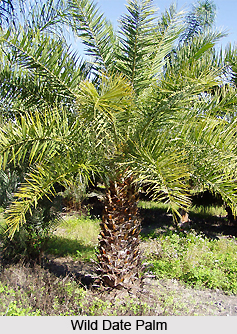 The `Wild Date Palm` is one of the most conspicuous trees in India. The scientific name of this tree is `Phoenix Sylvestris`. The word `Phoenix` came from the Greek language and it means "purple". The word `Sylvestris` means "wild" in Latin. Like some of the other palm trees, this tree is also a member of the `Palmae` family. In Hindi, this tree is known as `Sendhi`, `Salma`, `Khaji` and `Khajur`. In Bengali language, the name of this tree is `Khejur`. The Tamil people call it as `Itcham-pannai` or `Tnchu` and in Telugu it is named as `Peddaita`.
The `Wild Date Palm` is one of the most conspicuous trees in India. The scientific name of this tree is `Phoenix Sylvestris`. The word `Phoenix` came from the Greek language and it means "purple". The word `Sylvestris` means "wild" in Latin. Like some of the other palm trees, this tree is also a member of the `Palmae` family. In Hindi, this tree is known as `Sendhi`, `Salma`, `Khaji` and `Khajur`. In Bengali language, the name of this tree is `Khejur`. The Tamil people call it as `Itcham-pannai` or `Tnchu` and in Telugu it is named as `Peddaita`.
It is very much a common tree in India at present and in some of the regions, it is the only visible tree. The `Wild Date Palm` tree does not require Sun to flourish as it has the great capability of thriving under the shade. In some districts of India, it can cover a huge area by forming gregarious forest growths. In those places, the government has "Reserved" many of the forest. There, only a few individuals have the right to tap the Toddy from the trees. They can earn a considerable income by obtaining the Toddy.
This tree is small in comparison with the other palm trees as it can grow only 9 to 12 m in height usually. The stem of the tree is thick and the bases of fallen leaves cover it densely. In the lower down, the remaining scars cover the stem. A bunch of leaves emerges from the summit and more leaves issue from the sides. They form a wide, round crown. The long and arched leaves are divided into several, rigid leaflets. Each of the leaves is tipped with a sharp spine. These leaflets of the `Wild Date Palm` tree are like swords in shape and a grayish-green in colour. The leaflets on each side do not lie parallel like the leaves of the Coconut and Areca Palms. They grow alternately out and up. It means that, they grow in two planes and give the whole leaf a criss-cross, spiky effect.
You cannot find the male and female flowers in a single tree as in many other palms. They appear in the hot season and they are sheathed in a long, stout spathe. This spathe bursts to disclose many thickly crowded branchlets. The male flowers are smaller than the female ones and they are waxy and white. They appear on short stalks. On the other hand, the female flowers are greenish in colour and develop in clusters of three. Both the flowers are fragrant and they appear during the month of March. The fruits of the `Wild Date Palm` tree bears more importance than the flowers and they are much more conspicuous as well. They form on long pendulous stems that are nearly a meter in length. A number of bunches issue from the stems. The clustered fruits are round or oblong in shape. At the beginning, they are hard and green in colour, but with the course of time they become orange-yellow and brown when ripe. People make Jellies and Jams from these fruits. They also preserve the fruits, or powder them into a paste with locusts. A good palm is capable of developing dozens of clumps of fruit. Though the Date Palms give an excellent yield of palm-wine, the fruits of a freely tapped tree are inferior to those of one who is allowed to retain its sap. This extraction also spoils the appearance of a tree as the cutting makes the stem grow in a curiously zigzag fashion. The terminal bunch also becomes lop-sided for the extraction.
The surface is cut in a large V shape after a few days and a triangle is removed from the pith. The sap runs out and people carry it out down a channel into a container. The channel is made of bamboo or a Palmyra leaf rib. Then they renew the wound twice at intervals by paring a thin slice from the notch and after renewing, the tree is allowed to rest. The sap is either drunk fresh or boiled down to a brown sticky matter. People sell this sap of the `Wild Date Palm` tree to sugar refineries or distil it into a potent spirit. You can extract the sap only when the plant is seven to ten years old and about 1.2 m in height. The months of November to February are the tapping period. It is generally considered to be substandard to cane sugar.
The other parts of the tree also have their respective uses. You can make sleeping mats from the leaves and baskets from the leaf stalks. These are also twisted into ropes and used for drawing water from wells along with other things. In some places people chew the fruit with betel-leaf. There are eight species of `Wild Date Palm` found in India except the cultivated one.











